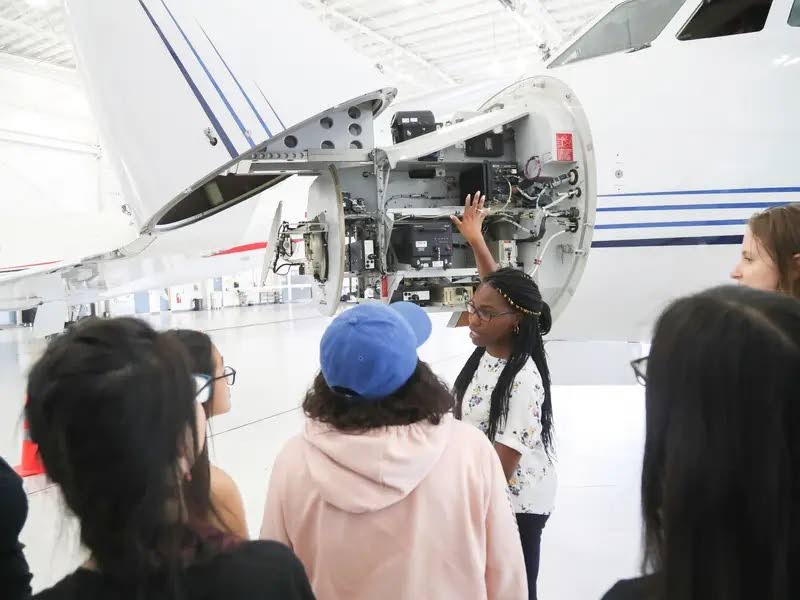Melissa Doughty
Lindsey Shepard, Chief Marketing Officer (CMO) of MOZILLA, thinks there are two main tips every woman in tech should keep in mind.
Don’t be afraid to talk about money and it’s not his job to be liked once in a leadership role.
For those unfamiliar with Mozilla, the American technology organization is known for its products such as the Firefox web browser.
She made the statement during Collision’s Women in Tech X virtual one-day event on June 2. The Royal Bank of Canada (RBC) was the main sponsor of the event.
Shepard spoke at one of the event’s breakout sessions titled How Women Will Lead a Post-Pandemic World. Tech website VentureBeat reporter Manasa Goginei hosted the event.
Shepard said women in tech, and in general, should stop being afraid to talk about money and be afraid to say what they need to.
“And recognize and demand that others recognize your value.
“Talk about money, it’s okay. They call it work for a reason. We are here to get paid,” she said.
“We are worth as much.”
She added that as women thought about leadership and became more serious about their careers, it was not their job to make people like them.
“I think women, in general, we’re taught, from an early age, that sympathy is a critical path to success and that’s something that men don’t learn.”
She said that once a woman is given the responsibility of leading a team, her job is to make that team successful, not to make sure she likes you.
The issue of women and girls in technology is growing given the covid19 pandemic and the rapid rise of digital technologies.
In commemoration of the International Day of Women and Girls in Science on February 11, President Paula-Mae Weekes then encouraged girls and women to pursue studies in the fields of science, technology, engineering and mathematics (STEM). A February 11 Newsday article quoted Weekes as saying, “because the nation and the world can only benefit from adding the female perspective.”
A March 3 Forbes article said that a recent study concluded that the gender gap for women in tech as a whole is actually worse today than it was in 1984.

“The study, conducted by Accenture and Girls who Code, showed that 50% of women leave tech careers by the age of 35 and that women leave tech roles at a 45% higher rate than men.
“Only 21% of women in the study said they thought the tech industry was a place where they could thrive; unfortunately, that number drops precipitously to 8% for women of color.
Accenture is a multinational consulting and processing company and Girls Who Code is a non-profit organization that aims to support and increase the number of women in IT.
The pandemic year was difficult for everyone but affected some more than others. The Forbes article states that in August and September 2020, 865,000 women left the workforce compared to 216,000 men.
When asked if companies had adapted their support systems for women during the year of the pandemic, Shepard said that the last year had been really difficult for women and that statistics on women leaving the market of work over the past year were “pretty crazy”.
It was a reality that could no longer be ignored. Corporate leadership teams no longer had the luxury of putting it aside and pretending it didn’t exist.
She said that for women and mums in particular, vacation days or wellness days weren’t relaxing but an opportunity to maybe “turn your head upside down without trying to do 16 things at once”.
At Mozilla, at the end of June, there is a week when the staff “unplugs for a week just to give everyone a breather”.
These accommodations are really important, Shepard said.
While much of the world is reopening and daycares and schools are reopening, that doesn’t mean children no longer exist, she said.
“Because there’s more support available to us, that doesn’t mean it’s not important to consider these different roles that women have in their lives.

Shepard personally subscribes to the concept of representation when thinking about inclusion, the gender gap, women in the workforce, and how to create an inclusive environment to encourage women.
“And how representation is really one of the most critical things when it comes to creating an inclusive environment.”
Explaining further, Shepard said people often think of a certain percentage of women needing to be in these groups.
For her, it was not about the number but about what it meant.
“If I’m a young woman starting out in her career, I’m not just looking for any woman to be a role model for me. I’m looking for someone like me and that means diversity of perspective. It means diversity in all sense.
“When we look at the numbers, it’s important to dig into them and understand what they mean, because it’s those points of intersectionality that can really make a difference.”
This applied to all types of diversity, be it diversity of thought, styles, communication or physicality.
“Without really pushing for all different types of women to be represented at all levels, you’re not going to inspire and encourage young women to become leaders.”
She remembers reading an article that said women who wore light makeup got more promotions than those who had fresh faces.
It boiled down to a toxic view of what it meant for women to look a certain way.
“But when you dig a little deeper, if you’ve ever had a female leader who doesn’t subscribe to conventional beauty standards, doesn’t wear makeup and similarly obsesses over Tik Tok makeup and tries all sorts of things fun and creative, both equally capable.
“If those elements aren’t represented equally, you’re really limiting your idea of women in leadership positions to one specific thing.”
She said women are not one thing but come in all shapes and sizes with different styles and approaches.
While recruitment pipelines (parts of a company’s recruitment process) are often talked about in tech and STEM and are real to some degree, girls lose interest in math and science around age eight, which is a societal problem, she said.
It starts before recruiting pipelines and thus Shepard does not buy into the recruiting pipeline being the culprit of the gender gap.
“I think there are just a lot of bright, talented, well-educated, capable women out there who would be really beneficial to tech companies. I think the issue is less about the pipeline and more about inclusivity.
She added that companies can hire a lot of people, but once they’re there, they feel bad.
“Or when they’re there, they’re the only woman in a room. Or once they’re there, every type of social activity is like max bro culture, they’re not going to stick around.

“They’re going to look for places where they feel more included.”
So to encourage more women in tech, “decent recruitment practices” are needed.
She suggested companies consider blind selection and/or having a diverse panel when interviewing.
“Understanding how to debias this process,” she said.
In the future, as workspaces shift more to screens, Shepherd thinks businesses should also normalize face mute, as women’s facial features play a “huge role” in how we are perceived in the workplace. of work.
“Once your recruiting processes are as biased as possible, it’s about thinking about inclusivity for the group of people you’re actually entering,” she said.

